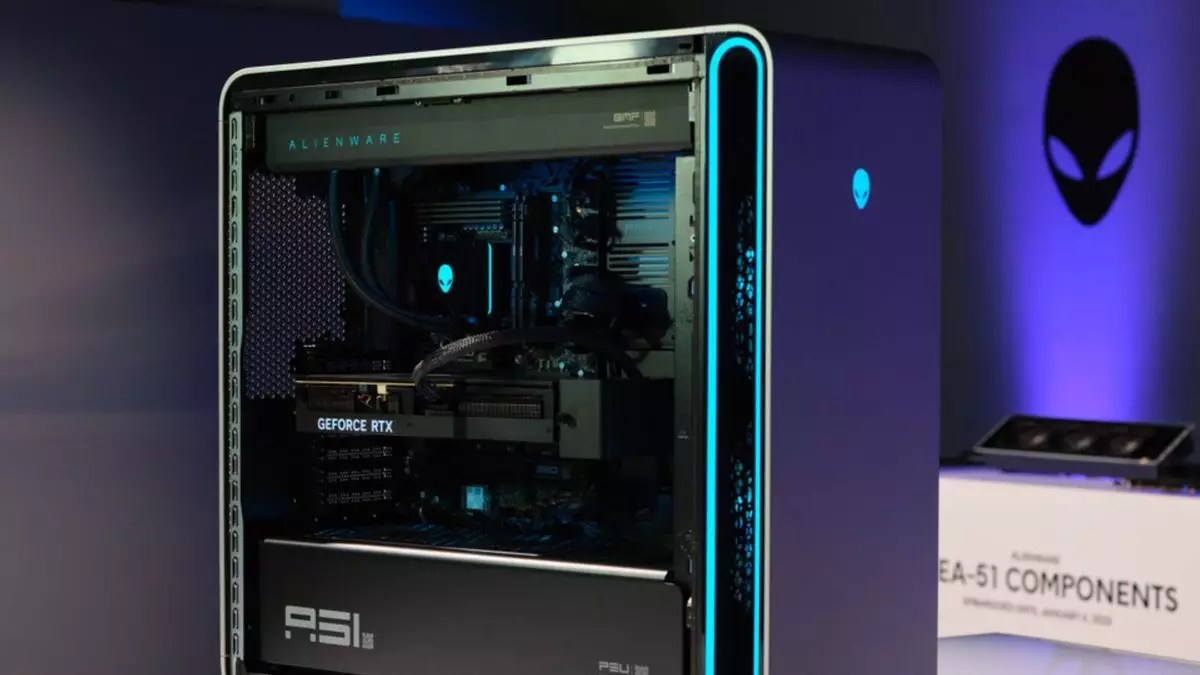Alienware has long positioned itself at the intersection of cutting-edge gaming technology and unique design aesthetics. The brand is notorious for producing high-performance gaming rigs that, while visually striking, often come with significant limitations regarding upgradability. This trend has raised eyebrows among gaming enthusiasts who seek to future-proof their investments. At CES, all eyes were on Alienware’s new Area-51 desktop, which boasted a revolutionary fully upgradeable design. However, the excitement surrounding this announcement was quickly dampened by hidden caveats that only the most astute consumers would spot.
A $35 Asterisk: Why Upgradeability Comes with a Price Tag
Buried within the enthusiastic marketing rhetoric lies an important condition: to fully seize the upgrade potential of the Area-51 desktop, users must purchase a special AlienFX board cable conversion kit for an additional $35. This kit is not merely a trivial accessory; it includes essential components such as a power switch wiring cable, fan power bridge, USB dongle extension, and even a bag of nuts—yes, literal hardware nuts. In their quest to promote innovation, Alienware has inadvertently inserted a significant hurdle in the upgrade path. More than just a minor inconvenience, this step serves as a stark reminder that even newfound modularity may come with additional costs that can frustrate consumers.
Exclusive Compatibility and Limitations
While the Area-51 desktop opens up some previously inaccessible upgrade paths—allowing the installation of any ATX12VO motherboard—the fine print reveals that older Area-51 models, such as the R4 which debuted in 2017, cannot utilize the new conversion kit. This limitation further complicates the appeal of Alienware’s upgrade promise. With the rapid evolution of technology, many gamers may not want to invest in a new desktop rig every few years, yet Alienware’s approach risks alienating dedicated fans (pun intended) who may own older models.
Impressive Aesthetics and Advanced Performance Features
It is hard to ignore that the new Area-51 desktop looks breathtaking. Sporting the latest RTX 50 series graphics cards and improved thermal management, the rig is designed for high performance while keeping noise levels remarkably low. With positive pressure airflow technology, the design seeks to reduce the accumulation of dust and hot air within the system—leading to longer life spans and better performance. Alienware touts that the newest model runs up to 13% cooler and operates 45% quieter than its predecessors—an impressive feat. Yet, one must ask: does aesthetic and performance prowess justify the limitations on upgrades?
The Upgrade Experience: A Double-Edged Sword
The introduction of a QR code next to major components for easy upgrade guidance indicates that Alienware is making strides toward a more user-friendly experience. Upgrades to GPUs, RAM, and SSDs remain unrestricted, which is a positive note for gamers who enjoy customizing their setups. However, the procedure for motherboard upgrades feels unnecessarily convoluted in contrast. While the allure of modularity and performance stands, the cumbersome addition of essential cables for a fully functional experience brings a bitter taste to the mouth of prospective buyers.
In many ways, Alienware’s novel Area-51 rig exemplifies what happens when innovation meets traditional limitations inherent in the gaming market. A combination of impressive tech features wrapped in an elegant chassis is admirable. Still, the necessary purchase of a conversion kit and compatibility restrictions remind us that the landscape of PC gaming is fraught with nuances.
Two Steps Forward, One Step Back
In essence, the narrative surrounding Alienware’s Area-51 desktop is an exploration of progress clouded by antiquated constraints. On the one hand, introducing a fully upgradeable design represents a notable shift in a gaming enterprise known for its restrictive systems. On the other, the undue costs and compatibility issues exhibit a hesitance to fully embrace a modular approach. Consumers expect an investment in gaming hardware to offer meaningful options for future enhancements without the added sticker shock. Despite the dazzling innovations, it’s disheartening to find that the path to an optimized gaming experience still has hurdles to clear.


Leave a Reply